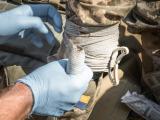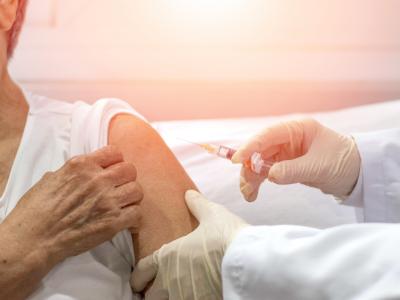In June 2015, executives from Ascension, the largest non-profit health system in the United States, joined other healthcare leaders at the White House Forum on Antibiotic Stewardship to announce their commitment to a 5-year action plan to implement an antimicrobial stewardship program (ASP) across Ascension's more than 140 hospitals.
"Antibiotic-resistant organisms are an increasingly significant—and potentially deadly—challenge in healthcare delivery," Ascension senior vice president Ann Hendrich, RN, PhD, told the gathering. "As an organization, we are compelled to find innovative ways to protect patients and improve outcomes—we strongly encourage others to do the same."
Soon enough, other hospitals will have to do the same. The president's National Action Plan for Combating Antibiotic-Resistant Bacteria, released in 2014, calls for strengthening antibiotic stewardship in inpatient, outpatient, and long-term care settings as part of a comprehensive approach to prevent resistance. In July, the Joint Commission, which accredits and certifies nearly 21,000 US healthcare organizations, approved a new medication management standard that requires hospitals to have an ASP starting Jan 1.
Finally, under new rules proposed by the Centers for Medicare & Medicaid Services (CMS), all hospitals will be required to have an ASP, along with a hospital-wide infection prevention and control program, in order to receive payment from the federal health insurance programs.
Some hospitals, like those in the Ascension network, are better prepared than others.
According to a May 2016 study from the Centers for Disease Control and Prevention (CDC), only 39% of more than 4,000 US acute care hospitals reported having an ASP that meets all seven of the CDC's Core Elements for Hospital Antibiotic Stewardship Programs. The researchers noted that the rate of hospitals in each state that followed all seven recommendations varied from 7% to 58%, with large hospitals (more than 200 beds) much more likely to have ASPs than hospitals with 50 beds or fewer.
"Our findings suggest that many hospitals need to add infrastructure and measurement support to their current actions to improve antibiotic use," the authors wrote.
While the CDC's Core Elements provide hospitals with a roadmap for creating an ASP, stewardship experts say there is no one-size-fits-all solution. Depending on facility size, staffing, and financial resources, stewardship programs will look different from one hospital to the next. But across the country, clinicians and pharmacists who are committed to reducing excessive and unnecessary antibiotic use are finding that certain elements are crucial for success.
Structure and accountability
For Mohamad Fakih, MD, MPH, senior medical director of Ascension's Center of Excellence for Antimicrobial Stewardship and Infection Prevention, creating an infrastructure for stewardship has been essential for establishing an ASP in a large, multi-state health system involving a variety of clinical settings. "If you don't have structure, it's not going to work," Fakih says.
That structure relies on executive and clinical commitment to the ideals of stewardship, which Fakih says creates accountability.
The accountability was established when Ascension's leaders went to the White House and made a public commitment to become a stewardship leader. That move made it clear to physicians, nurses, and pharmacists that stewardship would be a priority.
It was followed by the creation of an antimicrobial stewardship committee that established standardized criteria for use of certain antibiotics and disseminated guidelines to Ascension's local stewardship teams, which consist of a pharmacist and a physician.
But it's at the local level, Fakih adds, where stewardship is put into action. “The first key is having accountability at the system level, and the second is having champions at the local level," he says.
"It's very hard when a pharmacist is trying to push for something and the prescribing clinicians are just resisting. Nothing happens," Fakih says. "So they need to have a physician champion who is strong enough to make stuff happen at the local level."
And that physician doesn't necessarily have to be an infectious disease (ID) expert, since fewer than 20% of the smaller hospitals in the Ascension system don't have an ID physician on staff. What's more important than ID expertise , Fakih argues, is that the physician on the stewardship team be experienced enough and respected enough that when engaging on antibiotic de-escalation in a patient, for example, the other physicians will listen.
Structure, accountability, and clinical leadership, along with an electronic dashboard that enables Ascension pharmacists to monitor antibiotic use at all of the system's hospitals, have helped Ascension reduce systemic antibiotic use by 8%. Moreover, they've created an environment in which conversations around the four R's of antibiotic stewardship (right dose, right time, right antibiotic, right duration) are easier to have. "It's getting way better," Fakih says.
Handshake stewardship
Another hospital that is seeing an improved environment for stewardship is Children's Hospital Colorado (CHCO), a 450-bed pediatric hospital in Aurora. Unlike most ASPs, which tend to focus on the use of broad-spectrum antibiotics, the CHCO ASP submits all antimicrobial prescriptions to review by a stewardship team consisting of a pharmacist and an ID physician.
"Every single antibiotic, every single antiviral, every single antifungal," says Amanda Hurst, PharmD, an antimicrobial stewardship and clinical ID pharmacist at CHCO. On a typical day, she says, the team will come up with a list of roughly 20 patients that require antimicrobial interventions.
"When people are first trying to design a [stewardship] program, they of course want to look at the 'big guns,' but really where your benefit likely is are in those narrower antimicrobials that are used more frequently," Hurst says. And CHCO's data bear that out, showing that more of their stewardship team's interventions involve narrow-spectrum antibiotics like penicillin and ampicillin than the broad-spectrum agents.
But what also sets CHCO apart is how decisions about antibiotic use are conveyed. CHCO employs what is known as "handshake stewardship," in which the stewardship team does rounds with every inpatient clinical team each day and communicates antibiotic interventions face to face.
"We really wanted to be seen as a stewardship program," Hurst says. "We wanted to be up on the floor, to see where those challenges are, because it's really hard to understand a complete patient just by looking at their chart."
This model, Hurst adds, is particularly helpful in complex situations with very sick patients. In addition, interacting directly with the stewardship team enables prescribing physicians to bring up cases that haven't even been reviewed, which provides more opportunities for the stewardship team to educate providers about appropriate antibiotic use.
So far, this type of personal communication appears to be working. A study by Hurst and her CHCO colleagues in the October issue of the Pediatric Infectious Disease Journal found that from 2010 (when the program was implemented) to 2014, overall mean antimicrobial use at CHCO decreased by 11%. The impact was seen in all units of the hospital and across all classes of agents. A more recent study presented at IDWeek 2016 found that over a year and a half, the overall acceptance rate for interventions was 86%.
Hurst believes ward rounds should be the basis of all ASPs. "Seeing stewardship personnel every day is how you're going to embed stewardship into these programs," she says.
Fakih agrees, noting that this type of peer-to-peer interaction is much more valuable than communicating decisions through e-mail. "Connecting with each other and talking with each other is very key," he says.
Working with limited resources
But as impressive as the results at CHCO are, not every hospital has the resources to implement handshake stewardship. "I think it's a great model, but we don't have enough people here to do that," says Leslie Baken, MD, who directs the ASP for North Memorial Medical Center, a 250-bed trauma center just north of Minneapolis, and Maple Grove Hospital, a smaller community hospital.
"We have over 3,500 ID consults a year between the two hospitals, and I'm one physician," says Baken, the only ID physician currently on staff at North Memorial. "We're trying to grow the program." Baken says she hopes to be able to add more ID specialists on staff within the next year.
But while they may be short on ID specialists, what Baken and her stewardship partner Emily Herstine, PharmD, do have is a team of pharmacists who play an active role in implementing the policies and best practices outlined by North Memorial's antimicrobial stewardship committee. The ward-based pharmacists are responsible for dosing, reviewing patient charts, and conveying antibiotic interventions to prescribing physicians if they are necessary.
Herstine, an ID pharmacist, works regularly with the local pharmacists to educate them about stewardship and to answer any of their questions. But they are ultimately the ones who make antibiotic recommendations to clinical teams. Some of those conversations are face to face, but not all. For more complicated cases, Herstine and Baken will get involved.
"We try to do a number of education sessions so that all pharmacists are comfortable making different interventions," says Herstine.
The acceptance rate for interventions at North Memorial is around 90%. In addition, Baken says that since the ASP was implemented in 2009, the hospital has seen decreases in antibiotic cost per patient-day and days of therapy per patient-day.
While resources and communication are important, Herstine and Baken say having dedicated, knowledgeable stewardship leaders who are supported by hospital leadership is what really makes an ASP work. "If you don't have that, if it's just piled on to the pharmacists as one more thing to do, it's not going to happen," Baken says.
Hurst concurs. "If you don't have your pharmacy leadership, if you don't have infection control leadership—or your c-suite—engaged in your program, it's really difficult to make headway."
See also:
Joint Commission antimicrobial stewardship standard
Jun 6 CMS fact sheet
May 19 CDC study on hospital stewardship
CDC "Core Elements" stewardship page
October Pediatr Infect Dis J study























